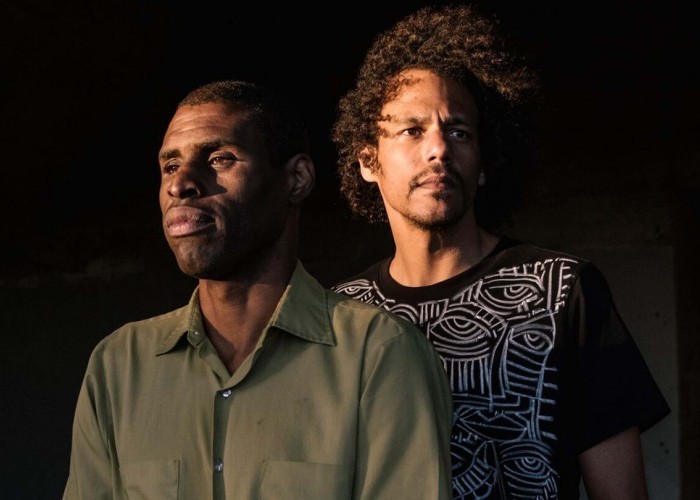Apr 2, 2024 12:59 PM
Saxophonist, Sonic Explorer Casey Benjamin Dies at 45
Casey Benjamin, the alto saxophonist, vocalist, keyboardist and producer who stamped his distinctive sounds on the…

Marshall Trammell (left) and Zachary Watkins are set to release Black Access/Black Axes (Sige), an album that will be Black Spirituals last recording with its current personnel.
(Photo: Mark Mahaney)The avant-improvisation duo Black Spirituals consists of two hyper-intelligent musicians, Marshall Trammell and Zachary Watkins, who have described their work as a continuation of centuries of American tradition and history, black resistance and black flight. The sonic manifestation of their music is surprising, dissonant, real, grounded and nothing short of brilliant.
The duo, which was founded in Oakland, California, during 2011, has toured with esteemed performers like Earth, ENDON and Saul Williams. But with all of its accomplishments, Black Spirituals has announced that its upcoming album, Black Access/Black Axes (Sige), which is set to be released July 6, will be its final recording. Watkins, who teaches at Canãda College and University of California, Santa Cruz, is set to continue on with the group—its future personnel undetermined.
No matter how searing, mind melting and moving this new album is, though, the recording marks the end of an era and a poignant point in the band’s history.
The following has been edited for length and clarity.
Before we get into the compositional makeup of Black Access/Black Axes, what does the album title mean?
Marshall Trammell: Axes is the plural of axis. The functions of our duo dynamic are simultaneous, yet set at different points of access—or disciplines.
Zachary Watkins: We enjoy access as American citizens, playing Europe on three separate trips with little bureaucracy. It is true that we were kept in UK customs long enough to miss our ride. Being broke, we had quite an adventure getting into London for that night’s concert. Marshall and I treat our performances as an opportunity to present new African-American forms. Here lies the “axe.”
Do you consider the recordings to be activism?
MT: Black Spirituals is a band project without any stated political agenda. I think we want to collide our different expressions and develop that synergy. At the same time, there are aspects of tactical media embedded in the graphic design of our album covers. The imagery on the cover of Of Deconstruction is an amalgamation—facilitated by Sige Records co-owner and graphic designer Faith Coloccia—of Underground Railroad quilt-block patterns and Zachary’s father’s pottery designs.
The new album cover designs are Faith’s original interpretations of Ghanaian musicologist Dr. Willie Anku’s structural organization of African percussion ensembles from his article “Circles And Time: A Theory Of Structural Organization Of Rhythm In African Music” from The Online Journal Of The Society For Music Theory. The images, sounds, text and other codes remain open to interpretation.
In the liner notes, we included an excerpt from Incidents In The Life Of A Slave Girl. This is an autobiography of a fugitive, formerly enslaved human being published in 1861 by L. Maria Child, who edited the book for its author, Harriet Ann Jacobs. The book documents Jacobs’ life as a slave and how she gained freedom for herself and for her children. Jacobs contributed to the genre of slave narrative by using the techniques of sentimental novels to address race and gender issues. She explores the struggles and sexual abuse that female slaves faced on plantations, as well as their efforts to practice motherhood and protect their children when their children might be sold away.
ZW: Just as you and I met through an interest in coalition building among artists of color, my goal has always been to link up and engage. Black bodies on white stages is the axe. My work with radical performance-artist group La Pocha Nostra is an example of creative activism exploring “borders.” My hyper-focused curation of artists of diverse backgrounds is an example of providing a platform for diverse creative voices. My AFFIRMATIVE ACTION collaborative concert is intended to challenge the normative culture of new-music communities. Lastly, as an educator of color, I am a potential model for others who seek creative expression.
Is Black Access/Black Axes going to be your last album as Black Spirituals?
MT: This is the last album that I will have a hand in.
ZW: I look forward to continuing Black Spirituals.

Benjamin possessed a fluid, round sound on the alto saxophone, and he was often most recognizable by the layers of electronic effects that he put onto the instrument.
Apr 2, 2024 12:59 PM
Casey Benjamin, the alto saxophonist, vocalist, keyboardist and producer who stamped his distinctive sounds on the…

“He’s constructing intelligent musical sentences that connect seamlessly, which is the most important part of linear playing,” Charles McPherson said of alto saxophonist Sonny Red.
Feb 27, 2024 1:40 PM
“I might not have felt this way 30 to 40 years ago, but I’ve reached a point where I can hear value in what people…

Albert “Tootie” Heath (1935–2024) followed in the tradition of drummer Kenny Clarke, his idol.
Apr 5, 2024 10:28 AM
Albert “Tootie” Heath, a drummer of impeccable taste and time who was the youngest of three jazz-legend brothers…

“Both of us are quite grounded in the craft, the tradition and the harmonic sense,” Rosenwinkel said of his experience playing with Allen. “Yet I felt we shared something mystical as well.”
Mar 12, 2024 11:42 AM
“There are a few musicians you hear where, as somebody once said, the molecules in the room change. Geri was one of…

Henry Threadgill performs with Zooid at Big Ears in Knoxville, Tennessee.
Apr 9, 2024 11:30 AM
Big Ears, the annual four-day music celebration that first took place in 2009 in Knoxville, Tennessee, could well be…